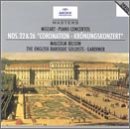| All Artists: Mozart, Gardiner, Bilson, Ebs Title: Piano Concertos Members Wishing: 1 Total Copies: 0 Label: Polygram Records Release Date: 8/15/1995 Genre: Classical Styles: Forms & Genres, Concertos, Historical Periods, Classical (c.1770-1830), Instruments, Keyboard Number of Discs: 1 SwapaCD Credits: 1 UPC: 028944728323 |
Search - Mozart, Gardiner, Bilson :: Piano Concertos
 | Mozart, Gardiner, Bilson Piano Concertos Genre: Classical
|
Larger Image |
CD Details |
CD ReviewsExploring the Mozart Piano Concertos -- K. 482 and K. 537 Robin Friedman | Washington, D.C. United States | 06/29/2004 (5 out of 5 stars) "With their beauty, virtuosity, urbanity, and passion, Mozart's 27 piano concertos are among the glories of music. This CD, recorded in the mid-1980s, features Malcolm Bilson, piano, and the English Baroque Soloists conducted by John Gardiner in performances of two Mozart concertos: the concerto in E-flat major, K. 482, and the "Coronation" concerto in D major, K.537. The performances are on period instruments. The piano sound is lighter and drier than the sound of modern pianos. It is more stacatto and detached than the modern piano sound -- a characteristic which sometimes surprises new listeners.Mozart composed the concerto in E-flat major, K. 482, in December, 1785. It is scored for strings, clarinet, bassoon, horn, trumpet, and tympani. This concerto is sometimes referred to as the "Queen" as a result of its grace, beauty, and majesty. It is one of my favorites among the Mozart concertos. Most listeners fall in love with it.The opening orchestral statement begins with a march theme contrasted by a brief, softer answer, and an assertive conclusion. The piano entrance is quiet and the solo part features much filigree, intricate scale passages, and a few moments of virtuoso chords. There is beautiful writing in the development in which the piano plays rising arpeggios in company with various combinations of woodwinds followed by a recapitulation of the opening material with substantial embellishment and variation.The second movement, marked andante, has long been considered the climax of this concerto -- Mozart himself had to repeat the movement at the premier of the work as a result of the enthusiasm of his audience. The movement is in a minor key and begins with a sad, mournful extended theme in the muted strings.
The piano enters quietly and plaintively, playing alone. The solo part is dry and spare and comes through well on the fortepiano used in this disk. The piano writing has a pleading quality and increases in passion and intensity as the soloist plays several duets with various wind combinations.The third movement, allegro, is a rondo with a gay, dancing theme as its refrain. As the movemement develops, Mozart inserts a slow minuet, as he had done in an earlier E-flat major piano concerto, K. 271. There is a long reprise of the main theme in the finale with much piano-wind interplay and false endings. Mozart wrote the piano concerto in D Major, K. 537 in 1788, two years after concluding the great series of piano concertos which included K. 482. It is his next-to-last piano concerto. The work was performed with Mozart at the piano in 1790 for the coronation of Leopold II and has been known as the "Coronation" concerto ever since. It is appropriately festive and accessible in character. Critical opinion has not been kind to the "Coronation" concerto, but this should not deter anyone from enjoying this music. It remains one of the most frequently performed of Mozart's piano concertos.The work is scored for strings, flute, oboe, bassoon, horn, trumpet, and tympani. The wind parts are less developed in this work than in many other Mozart concertos. In addition, the piano part is only lightly sketched out in places. This work is always performed from a score that edits and expands Mozart's own indications of the piano part.After a quiet opening, the orchestral introduction unfolds into a march theme featuring the tympani. A quiet secondary theme leads to a loud close and a running piano part, full of repeated scales and a flamboyant, but brief, virtuoso theme. The piano and the orchestra parts tend to alternate back and forth as the movement comes to a triumphant close.As is the case with K. 482, the climax of the "Coronation" concerto lies in its slow movement. It is marked "larghetto", but the tempo is that of a moderate walk. It does not have the sadness of the E-flat major work but consists instead of a quiet, reflective singing theme first stated by the piano. The piano in fact predominates throughout the movement with the orchestra coming into its own only towards the end.The finale of the "Coronation" concerto is a rondo stated first quietly by the piano and answered loudly by the orchestra. The movement is extensive and features a lengthy middle section before the return of the main theme and close.The concertos on this CD are well and idiomatically performed. The disk is a first-rate choice for listeners wishing to get to know the Mozart piano concertos. I find it best to approach these concertos on a work-by-work basis, rather than in a "complete" box set, to hear a variety of approaches to and interpretations of the music -- including period performances. Period performances, such as that offered on this CD are an excellent way, but not the only way, to capture the spirit of Mozart's piano concertos." |

 Track Listings (6) - Disc #1
Track Listings (6) - Disc #1